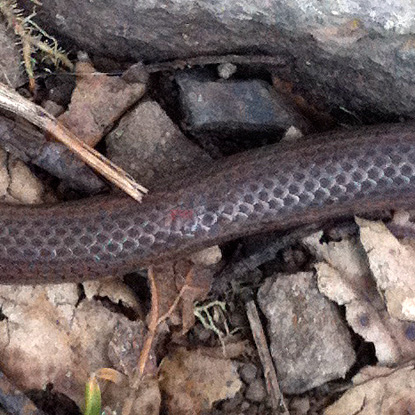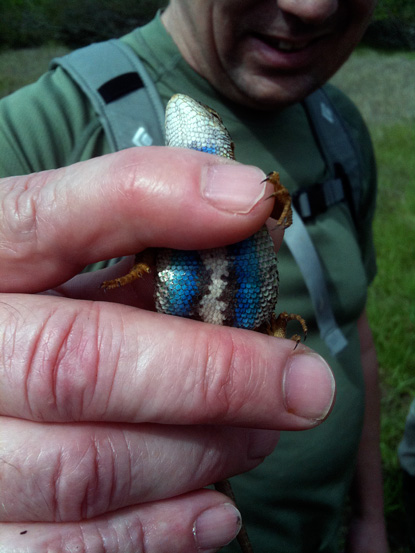NEW WEB SITE
In the next day or so, Supreme Gecko will have a new web site. The site will include photos, articles, videos, Hot Tips, and even Blog posts. I will occasionally post info here but if you want up to date, current information, you will want to check out our new Supreme Gecko web site.
MCSS and Chalets d' Anse Forbans – partners in turtle conservation
In March, long after the weekly monitoring had been discontinued by MCSS at the “end” of the 2009-10 Hawksbill Nesting Season, a turtle decided to emerge on Anse Marie Louise in front of Chalet No. 2. The sighting was reported to Brigitte Howarth, manager of Chalets d' Anse Forbans, who was on hand to ensure that the turtle was not disturbed by the many clients who were eager to photograph their first encounter with a nesting turtle.
As Elke was on the other side of the island, the turtle could not be marker tagged but as she has a distinctive scar, she is easily recognisable. In fact, according to Brigitte’s grandmother, the turtle had been seen nesting on the same beach some 6-7 years ago. Just to be on the safe side though, clients were instructed to take numerous profile shots which will be processed and added to the turtle photo-ID database.

Hawksbill turtle with distinctive scar bite mark nesting on Anse Marie Louise, Photo Chalet D’Anse Forbans.
The following day, Elke was on site to mark the nest and thus the long wait for the hatchlings to emergence began.

New nest markers designed by Elke in 2010 for sensitive nests, Photo Chalet D’Anse Forbans.
As the due date approached, there was concern for the turtle eggs as recent heavy rainfall and extreme high tides could significantly increase mortality rates within the nest. If the egg chamber remained waterlogged because of poorly drained soil, the embryos would suffocate or drown and the added moisture could encourage bacteria or fungal growth. This being the last nest of a rather poor nesting season, it was decided that the nest would be dug up and if necessary, the eggs incubated artificially to maximise the survival rate.
On the 5th May, Elke was on site to excavate the eggs which were due to hatch between the 4th and 19th May. Much to everyone’s surprise and delight the hatchling were resting some 10cm below the sand surface and, after being woken up by Elke, needed little encouragement to make the final trek to the sea.
Brigitte had rounded up her clients for the released and an impromptu turtle awareness talk given by Elke. By the time hatchling No. 159 made it to the sea, there were at least 20 very happy people on the beach, including a local building contractor who had come to see Brigitte for some work and had never seen a turtle in his life!

If the species is to survive, people need to be able to appreciate the wonder of nature, Photo Chalet D’Anse Forbans.
With 5 dead embryos in the nest, Elke was even able to get a DNA sample for Ifremer.
MCSS has been working closely with Chalets d' Anse Forbans in the South of Mahé since 2004 and over the years has received logistical and financial assistance for the MCSS Turtle Monitoring and Conservation Programme. While there may not be many nesting turtles on this beach, there are enough to keep the clients of Chalets coming back every year so they can finally see for themselves the one that got away. On-going rehabilitation work at the Chalets is also helping to provide suitable nesting sites for turtles on a beach that is severely affected by erosion.

Ms Daphné Jumeau of Chalets d' Anse Forbans (right) presenting MCSS with a cheque to help towards their ongoing work in the conservation of turtles in the Seychelles, Photo Chalet D’Anse Forbans.
NOTE: MCSS does not make it standard practice to dig up turtle nests, however, in special cases hatchling provide the perfect backdrop to turtle awareness talks for both residents and visitors, re-enforcing the need to protect these amazing animals.
Marin Headlands Herping
Somehow, I forgot to post about this adventure to Carson Falls, Mount Tam Watershed, in the Marin Headlands between Fairfax and Bolinas, CA, on March 20th of this year. It was during a family outing with my pals Todd, Teresa, their children Kyan and Kacia, along with friends Anna and Jen.

03/20/2010 @ 1:24:38 PM PDT
The local population of Foothill yellow-legged frogs (Rana boylii) are considered endangered. Nevertheless, we saw about 10 of them in the pools along the falls, so they're either doing reasonably well in this habitat, or Kyan and I are completely awesome frog spotters.

03/20/2010 @ 2:15:46 PM PDT
On the way back up the trail, we encountered this Pacific ringneck snake (D. punctatus amabilis). Shy and unassuming, it didn't bite, although like most non-venomous snakes in North America, it stunk up my hands with an escape musk. Notice the iridescent light on its scales. Jewelry should look as good as this.

03/20/2010 @ 2:16:49 PM PDT

03/20/2010 @ 2:17:37 PM PDT

03/20/2010 @ 2:21:58 PM PDT
Then, just a hundred yards further up the trail, we found this Sharp-tailed snake (Contia tenuis). Another unassuming resident of the leaf litter, it didn't try to bite, but it did put down a serious stink on me. Notice the severe scarring mid-body, probably the result of a bird attack, or perhaps an unobservant mountain biker.

03/20/2010 @ 2:21:53 PM PDT

03/20/2010 @ 2:26:58 PM PDT
Our last reptile encounter was with a Western fence lizard (Sceloporus occidentalis), also known as the Blue-belly. Its capture was accomplished by Watershed wildlife docent Peter Clare, who had some great stories about wildlife viewing adventures in Asia. These became the icing on the cake of a very successful day of herping.

03/20/2010 @ 1:24:38 PM PDT
The local population of Foothill yellow-legged frogs (Rana boylii) are considered endangered. Nevertheless, we saw about 10 of them in the pools along the falls, so they're either doing reasonably well in this habitat, or Kyan and I are completely awesome frog spotters.

03/20/2010 @ 2:15:46 PM PDT
On the way back up the trail, we encountered this Pacific ringneck snake (D. punctatus amabilis). Shy and unassuming, it didn't bite, although like most non-venomous snakes in North America, it stunk up my hands with an escape musk. Notice the iridescent light on its scales. Jewelry should look as good as this.

03/20/2010 @ 2:16:49 PM PDT

03/20/2010 @ 2:17:37 PM PDT

03/20/2010 @ 2:21:58 PM PDT
Then, just a hundred yards further up the trail, we found this Sharp-tailed snake (Contia tenuis). Another unassuming resident of the leaf litter, it didn't try to bite, but it did put down a serious stink on me. Notice the severe scarring mid-body, probably the result of a bird attack, or perhaps an unobservant mountain biker.

03/20/2010 @ 2:21:53 PM PDT

03/20/2010 @ 2:26:58 PM PDT
Our last reptile encounter was with a Western fence lizard (Sceloporus occidentalis), also known as the Blue-belly. Its capture was accomplished by Watershed wildlife docent Peter Clare, who had some great stories about wildlife viewing adventures in Asia. These became the icing on the cake of a very successful day of herping.
Turtles dig the dark
Nesting turtles emerge from the sea each season to lay their eggs on a suitable beach. After laying, they use light reflected off of the water to find their way back to the ocean. Sixty days later, when the hatchlings emerge from the nest, they too use the reflected light to find their way to the ocean for the first time.
As we develop coastal communities, building beach houses, shopping centres and high rise hotels and apartment buildings, we are splashing more light onto these nesting beaches. Unfortunately the lights are coming from the wrong direction and can cause turtles to become disorientated. Often they will end up on a road, in a pool, an easy snack for land-based predators such as dogs, or simply get lost and bake in the morning sun.

For this reason, many coastal communities have "lights out" regulations during turtle nesting season. These regulations often require home and business owners to take modest steps to install turtle-friendly lights, draw curtains, or turn lights out after dark.
MCSS developed lighting guidelines for Seychelles with funding from the British High Commission, but unfortunately these are not always being implemented by tourism establishments or residents.
 For a copy of the MCSS Turtle Friendly Developers Guide, please contact us.
For a copy of the MCSS Turtle Friendly Developers Guide, please contact us.Special issue of the Indian Ocean Turtle Newsletter out now
The Indian Ocean Turtle Newsletter (IOTN) provides a forum for the exchange of information on sea turtle biology and conservation, management and education and awareness activities in the Indian subcontinent, Indian Ocean region, and south/southeast Asia. The newsletter also intends to cover related aspects such as coastal zone management, fisheries and marine biology.

IOTN is distributed free of cost to a network of government and non-government organisations and individuals in the region. All articles are also freely available in PDF and HTML formats on the website. Readers can submit names and addresses of individuals, NGOs, research institutions, schools and colleges, etc for inclusion in the mailing list.
To date, 11 issues have been produced with the latest issue being dedicated to turtle projects in the Western Indian Ocean and features 10 articles, 2 project profiles and 1 announcement.
In support of the regional turtle conservation effort, MCSS contributed to an article on the newly developed photo-ID technique developed by Kelonia Marine Turtle Observatory and one project profile to raise awareness about the MCSS monitoring effort in Seychelles.
To download a digital copy, please visit: http://www.seaturtle.org/iotn/index.html
Various reptiles for sale
I have a few different animals for sale to make way for other projects. Please call me on 0408 865 284 if you are interested in any of the below animals.







Easter Water Dragons - Physignathus lesueurii lesueurii
I have an adult pair of EWD for sale. These lizrds have been housed outdoors for some time and would go great in a pit or large outdoor set up if that is what you are wanting. Female is missing the tip of her tail. Regretful sale - $150 the pair or $80 ea.


Storr's Monitor - Varanus storri ocreatus
1 adult male Storr's monitor. Shy animal, but a good captive. Eats most food items offered. I no longer have a female for this male so it's time for him to go. This is a class 2 animal in NSW. $300 ono


Children's Python - A. childreni
1 male 'red' Children's Python that was posted earlier in the blog. Great feeder on anything you offer him however he is snappy at times. $250 ono


4x4x2 Melamine Enclosure
I have a large melamine enclosure measuring 1200x1ooox600 (4x4x2 approx.) for sale. This enclosure has fixed vines and branches that can be unscrewed and removed to be cleaned. Glass sliding doors, ventilation, light fitting with light cage. $500 ono.

Please contact me if you are after any more info about any of the animals or items listed above.
Subscribe to:
Posts (Atom)